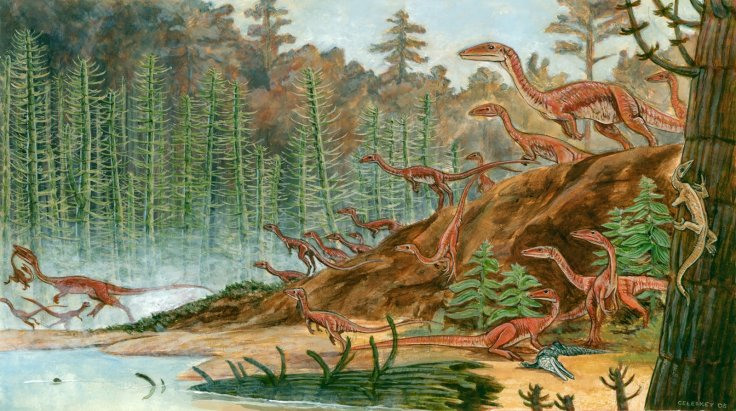Dinosaurs may have survived extinction events by having a huge range of body sizes

A single dinosaur species contained a huge amount of diversity in terms of the size that the animals grew to, a new study has found.
This sets dinosaurs apart from birds, which lost these broad ranges in size within a species or genus, according to a paper published in the journal PNAS. In the study the authors focused on the small and agile carnivore Coelophysis.
A large group of Coelophysis were buried together at the same time by a river in what is now New Mexico, about 208 million years ago. It's thought that an event such as sudden flooding may have killed this group of dinosaurs all at once.
The researchers analysed 174 fossils from the site to see how big the animals were across different life stages. Scars on the bones left from muscle attachment and marks where bones had fused together helped the researchers assess how mature the animals were compared with their size.
"We found that the earliest dinosaurs had a far higher level of variation in growth patterns between individuals than crocodiles and birds, their closest living relatives," says study author Christopher Griffin of Virginia Tech in the US.
"Not only were there many different pathways to grow from hatchling to adult, but there was an incredible amount of variation in body size, with some small individuals far more mature than some larger individuals, and some large individuals more immature than we would guess based on size alone."
Having a range of sizes of animals within Coelophysis may have given them an evolutionary advantage, the researchers say. For instance, it could have helped them to survive the tough conditions at the end of the Triassic – about 200 to 210 million years ago.
This variation could have helped dinosaurs survive the many extinction events in their history, Steve Brusatte, a paleontologist at the University of Edinburgh, who was not involved in the research, told IBTimes UK. "These sudden extinction events – such as the volcanic eruptions at the end of the Triassic – and they cause a lot of change really quickly," Brusatte says. "If you have a lot of variability, you have a greater size range and a greater chance of getting through some kind of catastrophic extinction. Of course we need to affirm this with more studies."
Политика конфиденциальности | Правила пользования сайтом







